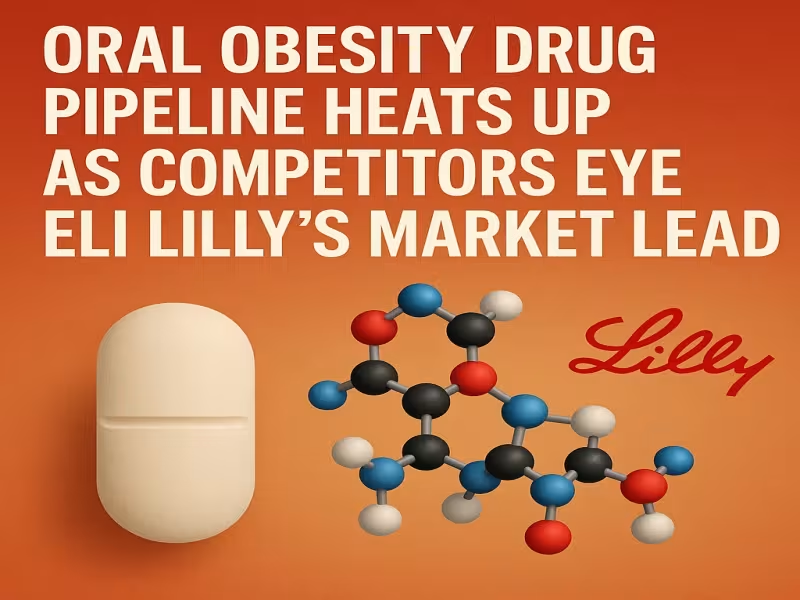
SHERIDAN, WYOMING – August 12, 2025 – Eli Lilly’s Phase III results for its next-generation oral GLP-1 therapy, orforglipron, have energized the already competitive obesity drug market, sparking renewed focus on oral weight-loss candidates poised to challenge the injectable-dominated landscape. While Lilly’s data confirmed significant efficacy, industry analysts see room for competitors to gain ground with differentiated mechanisms, dosing advantages, and manufacturing scalability.
The ATTAIN-1 study showed orforglipron achieved an average 12.4% weight reduction over 72 weeks, compared with 0.9% for placebo, with nearly 60% of high-dose patients losing at least 10% of body weight. However, analysts at Truist Securities and William Blair noted the therapy’s performance fell short of expectations set by leading injectable GLP-1 agonists—creating an opening for rivals.
Market Shift Toward Oral Obesity Therapies
Oral formulations are emerging as a critical differentiator in the $100+ billion projected obesity treatment market. Compared to injectables, pills present fewer barriers for needle-averse patients, allow for broader prescribing by primary care physicians, and are easier to manufacture and distribute at scale.
Graig Suvannavejh, managing director of Equity Research at Mizuho Securities, emphasized that oral small molecules “will be a ‘game changer’” due to their accessibility and potential to lower treatment costs. He added, “Having first mover to the market status will likely mean a lot,” noting Lilly’s established commercial infrastructure could accelerate uptake.
Key Competitors Advancing in Late-Stage Development
Several companies are pushing forward with oral obesity candidates that may secure market share alongside—or against—Lilly’s launch:
- Novo Nordisk’s Amycretin: An oral amylin analog targeting both GLP-1 and amylin pathways. Phase I oral data showed a 13.1% average weight loss over 12 weeks, with Phase III planning underway.
- Viking Therapeutics’ VK2735: A GLP-1/GIP dual agonist in Phase II testing. High-dose oral treatment achieved 8.2% average weight loss over 28 days.
- Roche’s CT-996: Acquired via the $2.7B Carmot deal, this pathway-biased GLP-1 analog achieved a 7.3% weight loss in four weeks in early trials, with Phase II planned for 2025.
- Terns Pharmaceuticals’ TERN-601: A GLP-1 receptor agonist with optimized pharmacokinetics, showing 5.5% weight loss over 28 days. Phase II results are expected by year-end.
- Rhythm Pharmaceuticals’ Bivamelagon: A melanocortin-4 receptor (MC4R) agonist targeting hypothalamic obesity, delivering BMI reductions up to 9.3% in 14 weeks.
Industry Trends and Strategic Implications
The competitive intensity in oral obesity drugs reflects broader market dynamics:
- Patient-centric formulation: Oral pills remove injection-related stigma, appealing to both general obesity patients and niche populations such as those with acquired hypothalamic obesity.
- Combination therapy potential: Emerging pathways like amylin analogs and MC4R agonists may eventually be layered with GLP-1 agents for synergistic effects.
- Pricing and access leverage: Lower production costs for small molecules could support competitive pricing strategies, particularly important for payer adoption.
Analysts point to historical parallels, such as Pfizer’s Lipitor overtaking earlier statins despite not being first to market, as evidence that early entrants like Lilly may still face significant competitive pressure.
Expert Perspective on Market Opportunity
Despite safety considerations—including gastrointestinal side effects reported across the class—analysts remain optimistic about long-term market expansion. “Orals have less of a learning curve for patients to self-apply,” said Suvannavejh, adding that ease of use could widen adoption among primary care physicians and retail pharmacies.
Outlook for Providers and Investors
For hospitals, health systems, and obesity clinics, the diversification of oral obesity drug options could broaden patient eligibility, simplify prescription workflows, and reduce dependency on specialty injection services. For investors, the crowded pipeline underscores the importance of differentiating on efficacy, tolerability, and payer positioning.
Late-stage readouts across multiple mechanisms are expected over the next 12–18 months, setting the stage for potentially transformative shifts in the global obesity treatment market.